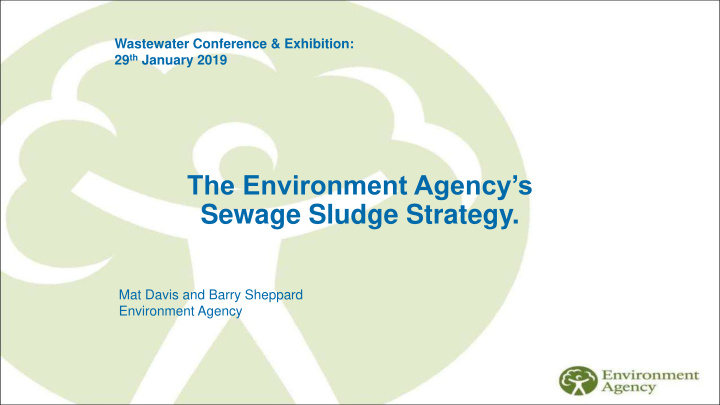



Wastewater Conference & Exhibition: 29 th January 2019 The Environment Agency’s Sewage Sludge Strategy. Mat Davis and Barry Sheppard Environment Agency
Environment Agency Sewage Sludge Strategy: Drivers for change: Complexity of the supply chain. Complexity of modern society. Veteran framework.
Environment Agency Sewage Sludge Strategy: Aim to: Modernise and clarify the regulatory framework that relates to sewage sludge treatment, storage and use. Address inconsistency with the other organic waste sector. Set in place investigations to evidence possible risk posed by modern sewage sludge practices.
1) Modernise and clarify the regulatory framework: Sources of environmental regulation: Europe Waste Framework Directive Urban Waste Water Treatment Directive Integrated Pollution Prevention & Control Directive (Industrial Emissions Directive) Sludge Directive. Sources of environmental regulation: England Environmental Permitting Regulations Urban Waste Water Treatment Regulations Controlled Waste Regulations Sludge (Use in Agriculture) Regulations.
1) Modernise and clarify the regulatory framework: 5
1) Modernise and clarify the regulatory framework: Waste water treatment plant Recovery to agricultural land Sludge (Use in Agriculture) Regulations Waste water. Other waste water. Waste in a liquid form. Sludge (various). Waste management facility Recovery to land Solid waste. Environmental Permitting Regulations INPUT TREATMENT USE
2) Address inconsistency with the other organic waste sector WE SUPPORT THE WASTE HIERARCHY WE WANT RECOVERY WITHOUT HARM Recovery of materials to land being used to improve soil or substitute for manufactured and quarried fertilisers or liming materials, without causing unacceptable harm to soil or the wider environment.
2) Address inconsistency with the other organic waste sector Environment Agency regulatory design principles: Regulatory Model (EPR example): Outcome focussed e.g. deliver waste hierarchy while protecting Site Permit human health and the environment. Bespoke Mobile Permit Risk based e.g. hazard Risk assessment to reduce uncertainty Mobile Plant and interventions to prevent pollution or harm. Exemption Proportionate e.g. apply polluter pays principle. Regulatory Effort
3) Set in place investigations to evidence possible risk posed by modern sewage sludge practices Traditionally a farmer ‘feeds’ soil with nutrients, lime and organic matter in order for that soil to support their planned crop rotation. Increasingly the soil’s diet is thought to be changing…
3) Set in place investigations to evidence possible risk posed by modern sewage sludge practices UKWIR Chemical Investigation Programme (CIP). Mission Statement on microplastics. Mission Statement on Anti-microbial resistance. Sludge investigation at the entry to sludge treatment and at the point of dispatch to land. Investigation into the mechanisms of chemical removal.
Environment Agency Sewage Sludge Strategy Concluding Remarks Project Manager appointed: Steve Foster. Engagement happening with the water industry and waste industry, and with others. In scope is the treatment, storage and final use of sewage sludge. Working to three general principles: Modernise and clarify the regulatory framework that relates to sewage sludge. Address inconsistency with the other organic waste sector. Set in place investigations to evidence possible risk posed by modern sewage sludge practices.
Thank you Mat Davis Technical Adviser Environment Agency
Recommend
More recommend